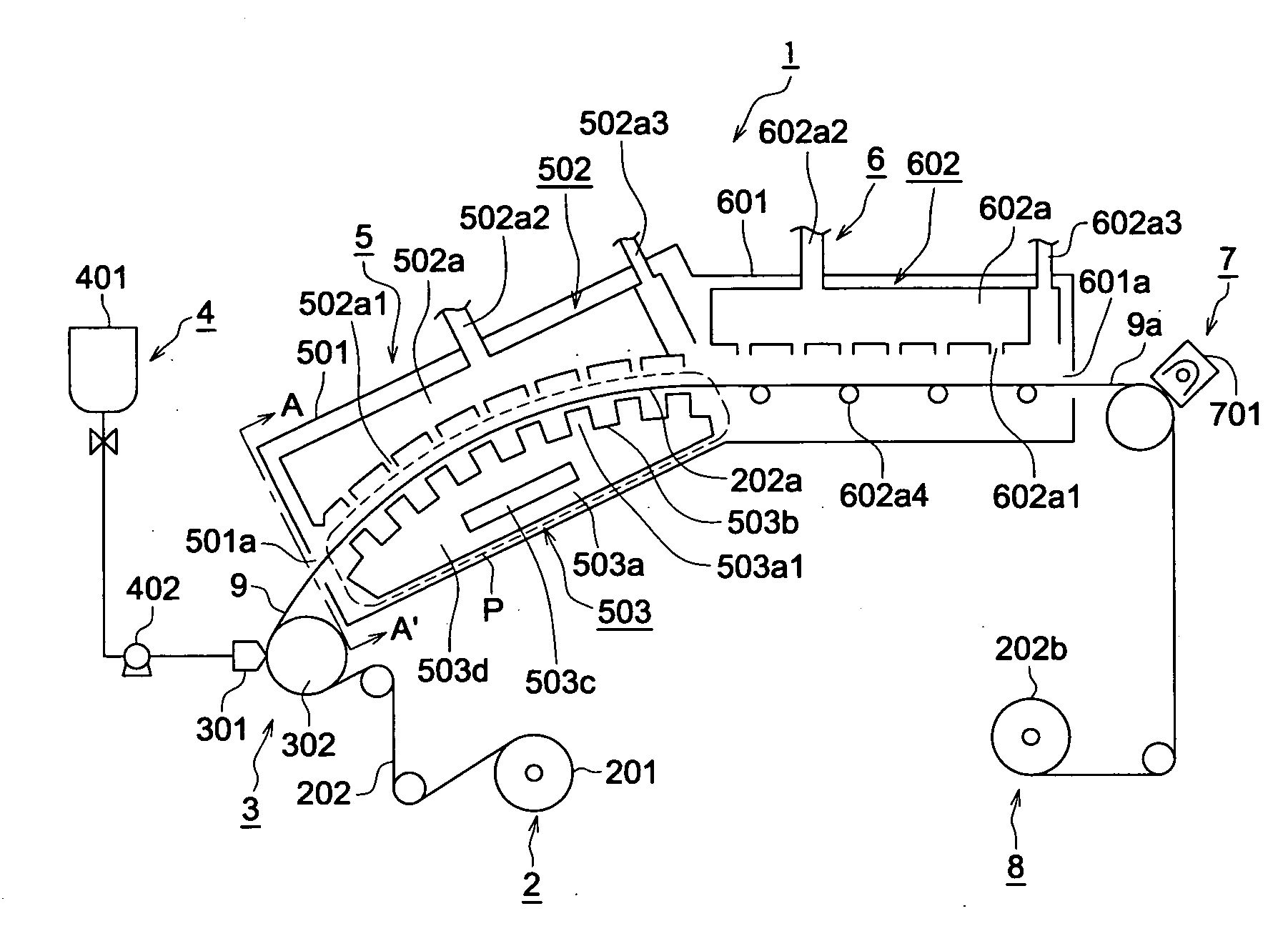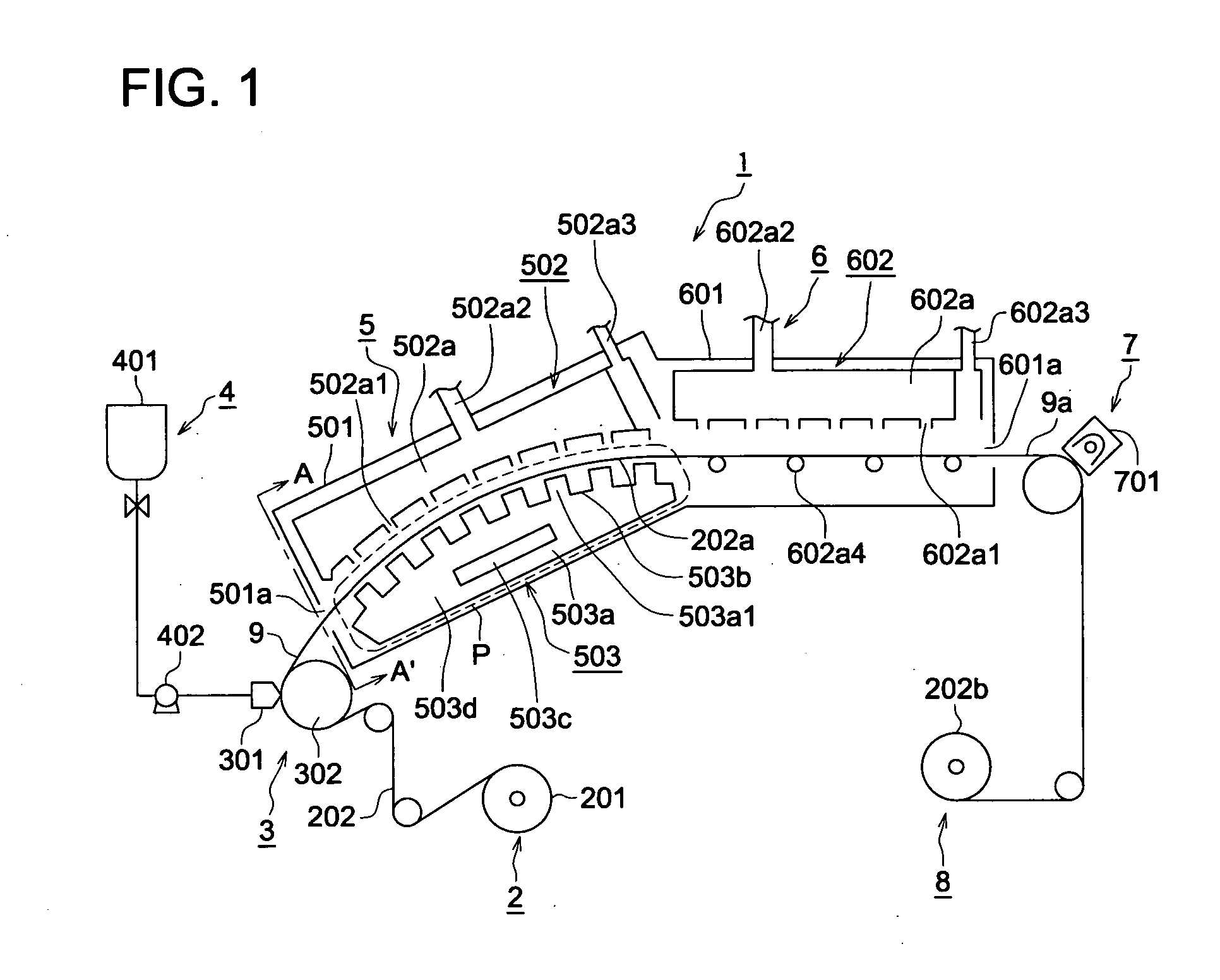Method for production of functional film, substrate conveyance apparatus, and functional film produced with the method
a technology of functional film and substrate, which is applied in the direction of drying machines, drying, lighting and heating apparatus, etc., can solve the problems of surface smoothness deterioration, irregularities or other defects, and problems such as problems that tend to occur, and achieve the effect of improving quality and improving productivity
- Summary
- Abstract
- Description
- Claims
- Application Information
AI Technical Summary
Benefits of technology
Problems solved by technology
Method used
Image
Examples
example 1
>
[0232] A cellulose ester film as a resin film substrate was produced by preparing various types of liquid additives and dopes as shown below.
[0233] (Production of Cellulose Ester Film)
AEROSIL R972V (produced by Nippon Aerosil Co.,1 kgLtd.)Ethanol9 Kg
[0234] Silicon Oxide Dispersion Liquid A was prepared via the steps of stirring and mixing the foregoing material in a dissolver for 30 minutes, and dispersing the mixture using a Manton-Gaulin high pressure homogenizer.
Cellulose triacetate (at an acetyl group replacement 6 kgratio of 2.88)Methylene chloride140 kg
[0235] Liquid Additive B was prepared via the steps of ppuring the foregoing material into an enclosed container, heating and stirring to completely dissolve the mixture and filtering the mixture. This was followed by the steps of adding 10 kg of foregoing Silicon Oxide Dispersion Liquid A to the mixture while stirring, further stirring the mixture for another 30 minutes, and filtering the mixture.
example 2
[0256] The cellulose ester film containing the same clear hard-coat layer as that of Sample No. 104 produced in Example 1 was produced under the same conditions using the same components. The following intermediate refractive layer formation coating solution was applied on the clear hard-coat layer by an extrusion type die coater. After that, keeping the dry air temperature of the first drying machine at 80° C., the cellulose ester film containing the intermediate refractive layer formation coated film was float-supported and conveyed by the cited conveyance apparatus, until the solid concentration in the intermediate refractive layer film did not exceed 80% by volume. The coated layer was dried, and any residual solvent in the coated layer was removed in the second drying apparatus at 120° C. After that, in the curing section, the coated layer was exposed to ultraviolet rays at a light intensity of 300 mJ / cm2, and was then cooled to room temperature. The film was then wound on a co...
example 3
>
[0268] Using the same material and method as those used in Example 1, both edges of the film were knurled to a width of 10 mm and a height of 10 μm, whereby a long and wide cellulose ester film was produced. This film had a thickness of 80 μm, a width of 1,400 mm, and a length of 2,500 m.
>
[0269] Using the coating / drying apparatus of FIG. 1, the following steps formed a clear hard-coat layer. One surface of the cellulose ester film was coated with the same clear hard-coat layer coating solution as that of Example 1, using an extrusion type die coater. The film was float-conveyed while the conveyance rate was regulated as required, to ensure that the solid concentration M at the terminal point of the first drying apparatus would be as shown in Table 3. Otherwise, the procedure was carried out under the same condition as those of Sample No. 104. Thus, a coated layer was formed and cooled to room temperature. Then the film was wound on a core in the recovery section, whereby Samples N...
PUM
| Property | Measurement | Unit |
|---|---|---|
| pressure | aaaaa | aaaaa |
| pressure | aaaaa | aaaaa |
| length | aaaaa | aaaaa |
Abstract
Description
Claims
Application Information
 Login to View More
Login to View More - R&D
- Intellectual Property
- Life Sciences
- Materials
- Tech Scout
- Unparalleled Data Quality
- Higher Quality Content
- 60% Fewer Hallucinations
Browse by: Latest US Patents, China's latest patents, Technical Efficacy Thesaurus, Application Domain, Technology Topic, Popular Technical Reports.
© 2025 PatSnap. All rights reserved.Legal|Privacy policy|Modern Slavery Act Transparency Statement|Sitemap|About US| Contact US: help@patsnap.com



